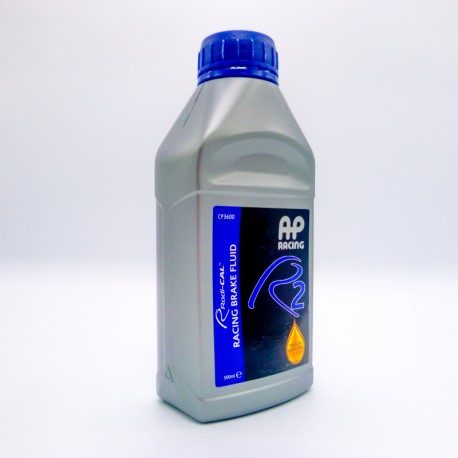 View larger
View larger
AP RACING BRAKE FLUID R2 600 0.50L 312°-195°
CP3600-20
LF-APR2-0.50LNew product
Radi-CAL™ R2 - Racing Brake Fluid 600 Re-branded as Radi-CAL™ R2 - Silver bottle with Blue cap. R2 fluid has a dry boiling point exceeding 300°C and has been developed for racing applications where high temperatures are being experienced, e.g. when using carbon discs and the ultimate in brake fluid performance is required. It should be noted that before using R2 fluid, any existing brak...
Volume discounts
| Quantity | Discount | You Save |
|---|---|---|
| 10 | 10% | Up to 29,38 € |
| 20 | 15% | Up to 88,14 € |
More info
Radi-CAL™ R2 - Racing Brake Fluid
600 Re-branded as Radi-CAL™ R2 - Silver bottle with Blue cap.
R2 fluid has a dry boiling point exceeding 300°C and has been developed for racing applications where high temperatures are being experienced, e.g. when using carbon discs and the ultimate in brake fluid performance is required.
It should be noted that before using R2 fluid, any existing brake fluid should be drained completely from the brake system. The system should be thoroughly purged with new R2 and can be filled completely with new R2 fluid.
Designation.
- Radi-CAL R2
‘Typical’ Boiling Points.
- New Dry 312°C
- ‘Wet’ E.R. 204°C
ADDITIONAL INFORMATION :
To obtain the best performance from racing brake systems, bleed the system thoroughly, immediately prior to each event using AP Racing brake fluid from a new sealed bottle. This is particularly important in wet or humid conditions or when the brakes are excessively hot. Always use fresh fluid and replace bottle cap when not in use. Never re-use brake fluid.
The use of a high temperature fluid should not be used as a substitute for proper brake cooling. Brake temperatures can be determined using AP Racing temperature stickers (CP2650-11) and thermal paints (kit No CP2649-5). If you require advice please Contact Us.
SILICONE BRAKE FLUIDS – A WORD OF CAUTION
AP RACING NEITHER MARKETS SUCH FLUIDS NOR RECOMMENDS THEIR USE WITH OUR OWN OR ANY OTHER BRAKING SYSTEM
Virtually all of the problems with Silicone Brake Fluids relate to:
Long/spongy pedal
Sudden loss of brakes
Hanging on of brakes
They reflect certain properties of silicone fluids identified by us over many years and recently ratified in SAE publications, namely:
High ambient viscosity
High air absorption
High compressibility
Low lubricity
Immiscibility with water
Research has shown that the relationships between problems reported and properties identified may be expressed as follows:
Long /Spongy Pedal
a) Compressibility, up to three times that of glycol based fluids
b) High viscosity, twice that of glycol based fluids, leading to slow rates of fill and retention of free air entrapped during filling, and hence bleeding difficulties.
Sudden loss of brakes
a) Air absorption. Gasification of absorbed air at relatively low temperature produces vapour lock effect.
b) Immiscibility (failure to mix) with water. Whilst the presence of dissolved water will reduce the boiling point of glycol based fluids any free water entrapped in silicone-filled systems will boil and produce vapour lock at much lower temperatures (100°C or thereabouts)
- Hanging on of brakes
a) Low lubricity. In disc brake systems the sole mechanism for normalisation of system pressure upon release of pedal pressure is a designed-in tendency of seals to recover to their ‘at rest’ attitude. Low lubricity works against this tendency.
b) High viscosity exacerbates the effect of (a) above.
It should not be assumed, therefore, that the high price of silicone fluids implies higher performance in hard driving or even normal road use.
AP Racing glycol based fluids do not contain the adverse properties described above. The recently introduced Factory R DOT 5.1 which exceeds the performance criteria of DOT 5 (Silicone), is suitable for all conditions likely to be encountered in modern driving conditions.
- Recommended Shelf Life
The recommended shelf life of an unopened fluid bottle is 18 months. AP Racing recommend any fluid manufactured after that time to be disposed off and not used.


